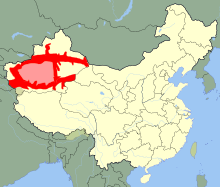Uyghur language
Turkic language spoken by the Uyghur people
Uyghur (ئۇيغۇرچە, Uyghurche;[3][4] formerly known as Eastern Turkish) is a Turkic language with 8 to 11 million speakers, spoken primarily by the Uyghur people in the Xinjiang Uyghur Autonomous Region of Western China. There are several writing systems used to write Uyghur. While Uyghurs usually use the Uyghur alphabet, an alphabet based on the Arabic alphabet, there are also two Latin and one Cyrillic alphabet that can be used to write Uyghur.
| Uyghur | |
|---|---|
| Uighur | |
| ئۇيغۇرچە / ئۇيغۇر تىلى | |
 Uyghur written in Perso-Arabic script | |
| Pronunciation | [ʊjʁʊrˈtʃɛ], [ʊjˈʁʊr tili] |
| Native to | |
| Ethnicity | Uyghur |
Native speakers | 25 million (2016)[1] |
Turkic
| |
Early forms | Karakhanid
|
| Arabic (official, Uyghur alphabet) Latin Cyrillic | |
| Official status | |
Official language in | |
| Regulated by | Working Committee of Ethnic Language and Writing of Xinjiang Uyghur Autonomous Region |
| Language codes | |
| ISO 639-1 | ug Uighur, Uyghur |
| ISO 639-2 | uig Uighur, Uyghur |
| ISO 639-3 | uig Uighur, Uyghur |
| Glottolog | uigh1240 Uighur |
 Geographical extent of Uyghur in China | |
Uyghur edition of Wikipedia, the free encyclopedia
References
change- ↑ Uyghur at Ethnologue (18th ed., 2015)
- ↑ "China". Ethnologue.
- ↑ In English, the name of the ethnicity and its language is spelled variously as Uyghur, Uighur, Uygur and Uigur, with the preferred spelling being Uyghur. Many English speakers pronounce it as /ˈwiː.ɡər/, though the native pronunciation is [ʔʊjˈʁʊr]. See Mair, Victor (13 July 2009). "A Little Primer of Xinjiang Proper Nouns". Language Log. Retrieved 16 July 2009.
- ↑ Its name in other languages in which it might be often referred to is as follows:
- simplified Chinese: 维吾尔语; traditional Chinese: 維吾爾語; pinyin: Wéiwú'ěryǔ in Chinese
- Уйгурский (язык) (transliteration: Uygurskiy (yazyk)) in Russian